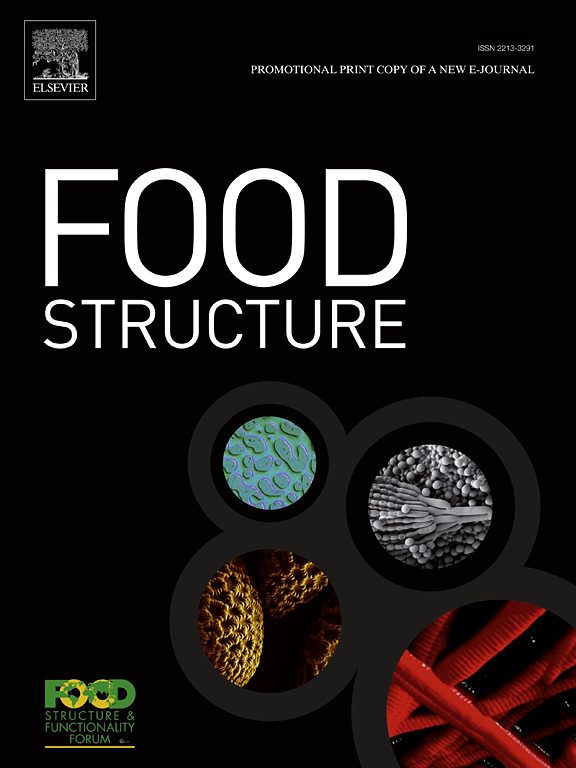Malondialdehyde and peroxyl radical-driven oxidation of myofibrillar proteins to improve the gelation and emulsification properties
IF 5.6
3区 农林科学
Q1 FOOD SCIENCE & TECHNOLOGY
引用次数: 0
Abstract
During meat processing, the oxidation of fats and oils generates peroxyl radicals (ROO·) and malondialdehyde (MDA) which influence the gelation and emulsification properties of myofibrillar protein (MP). In this study, we investigated molecular structural changes and alterations in the functional properties of MPs induced by oxidation with MDA and ROO·. The results revealed that oxidation significantly increased the levels of di-tyrosine and carbonyl groups, and led to an initial reduction, followed by an increase, in average particle size (P < 0.05). Spectroscopic analysis indicated that mild oxidation induced structural stretching in MPs, exposing internal hydrophobic groups and enhancing surface hydrophobicity. Additionally, the α-helix content of MPs decreased from 43.62 % and 44.12–31.69 % and 33.87 %, respectively. Our findings revealed that an optimized oxidative environment can significantly enhance the rheological properties, cooking loss and WHC of MPs. Specifically, gel hardness exhibited a biphasic response to oxidation, initially decreasing at low levels of oxidation and subsequently increasing as oxidation intensified. Furthermore, moderate oxidation by MDA and ROO· was found to improve both the emulsifying activity (EAI) and emulsifying stability (ESI) indexes of MPs, suggesting potential applications in enhancing the texture and stability of processed meat products.
丙二醛和过氧自由基驱动的肌纤维蛋白氧化,以改善凝胶和乳化性能
在肉类加工过程中,油脂氧化产生过氧自由基(ROO·)和丙二醛(MDA),影响肌纤维蛋白(MP)的凝胶化和乳化特性。在本研究中,我们研究了MDA和ROO·氧化诱导MPs的分子结构变化和功能特性的改变。结果表明,氧化显著增加了二酪氨酸和羰基的水平,导致平均粒径先减小后增大(P <; 0.05)。光谱分析表明,轻度氧化引起MPs的结构拉伸,暴露内部疏水性基团,增强表面疏水性。MPs α-螺旋含量分别从43.62 %、44.12 ~ 31.69 %和33.87 %下降。结果表明,优化的氧化环境可以显著提高MPs的流变特性、蒸煮损失和WHC。具体来说,凝胶硬度对氧化表现出双相反应,在低水平氧化时开始下降,随后随着氧化加剧而增加。此外,MDA和ROO·的适度氧化可以提高MPs的乳化活性(EAI)和乳化稳定性(ESI)指标,这表明MPs在改善肉制品质地和稳定性方面具有潜在的应用前景。
本文章由计算机程序翻译,如有差异,请以英文原文为准。
求助全文
约1分钟内获得全文
求助全文
来源期刊

Food Structure-Netherlands
Chemical Engineering-Bioengineering
CiteScore
7.20
自引率
0.00%
发文量
48
期刊介绍:
Food Structure is the premier international forum devoted to the publication of high-quality original research on food structure. The focus of this journal is on food structure in the context of its relationship with molecular composition, processing and macroscopic properties (e.g., shelf stability, sensory properties, etc.). Manuscripts that only report qualitative findings and micrographs and that lack sound hypothesis-driven, quantitative structure-function research are not accepted. Significance of the research findings for the food science community and/or industry must also be highlighted.
 求助内容:
求助内容: 应助结果提醒方式:
应助结果提醒方式:


